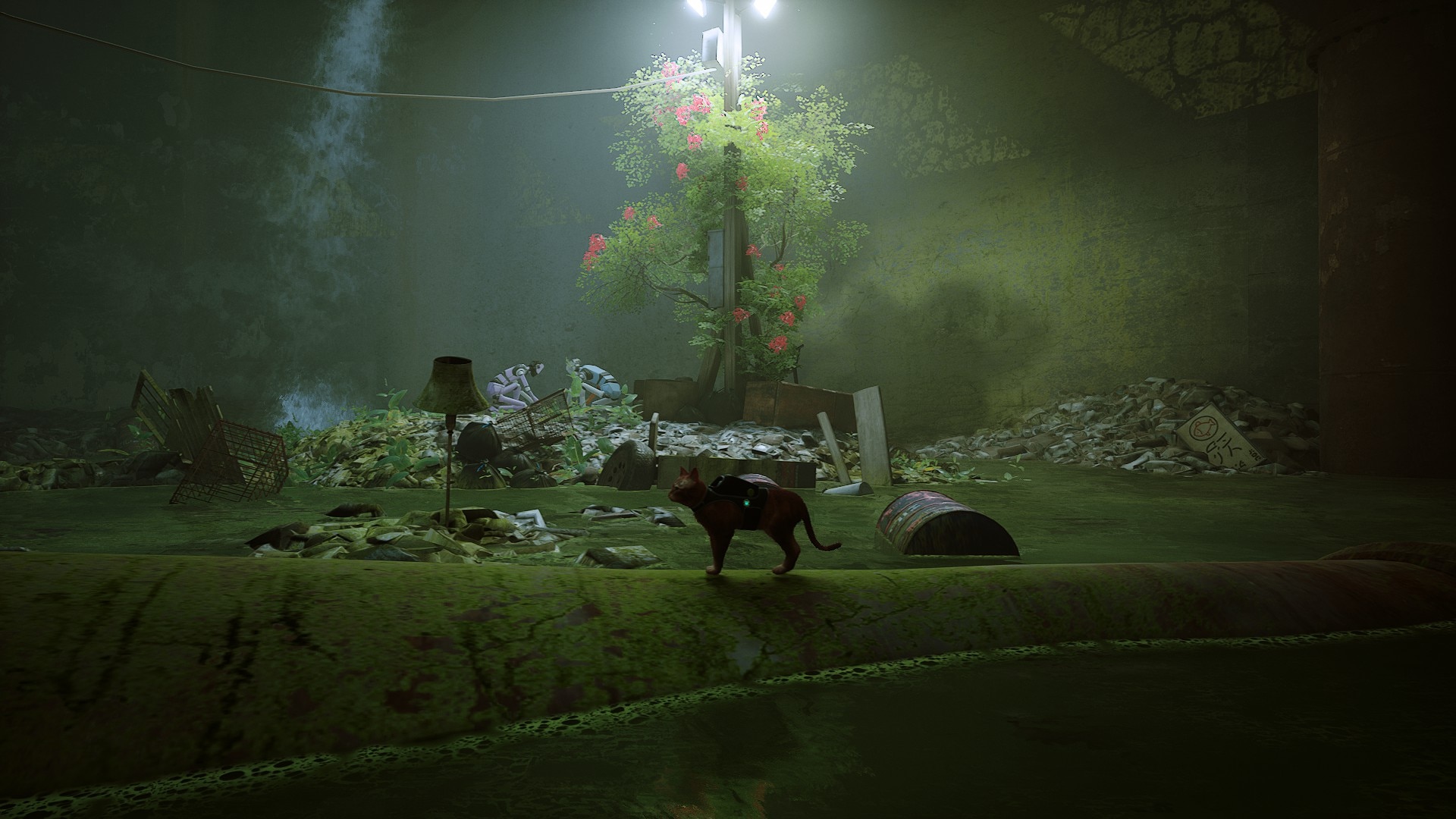Stray’s post-apocalyptic landscape is rooted in humanity's past – and that’s devastating
Feline fine

I yawn as I stretch my limbs out, one after the other, and toss a token glance of appreciation to the busker. He doesn’t seem to notice, though. He’s playing the guitar, rapt by the movement of his metallic fingers over the worn frets. Musical notes he’d long forgotten are spilling out into the nighttime air, and nobody knows how to react. Some pause momentarily, awkwardly pulling their puffer jackets about their shoulders that much tighter. It’s a useless, practiced habit, like how others reach beneath their hats to scratch at nonexistent itches.
Unbothered, I leap up onto the awning above the busker’s head. That air conditioning unit opposite looks particularly inviting, its thin rattle promising a cozy nap spot. Another nap sounds good right about now. Why rush? I’m just a cat. I have all the time in the world.
Land after time

Stray was 2022’s viral hit. The 3D platformer where you play a small cat wearing a backpack, exploring a world of grimy side streets, market stalls, and robots drew in cooing millennials who remember the Can I Haz Cheezburger days with a strange mix of fondness and cringe. Even Gen Z kids fell in love with the ginger tabby cat, the feline version of the everyman that even our favorite four-legged friends can enjoy.
With no humans left to create and progress the world further, Stray shows us how those we leave behind might mourn our passing by simply replaying our greatest hits.
But beneath the soft fur, the dedicated meow button, and some ethically-questionable combat sequences, Stray’s world is a sobering picture of what the future might look like if we aren’t too careful with our present.
In Stray, humanity is a distant memory, and the machines we’ve built have outlived us. The cat is both a passive bystander and unwilling catalyst, mildly observing this artificial world that humanity built but couldn’t maintain. In many ways, Stray’s walled city itself is the real main character.
Stray’s claustrophobic landscape is based on a very real place: Hong Kong’s Kowloon Walled City, a virtually lawless city within a city that ignored the rules of the world around it and operated on its own terms. Unlicensed dentists ran practices out of tiny rooms, built into the back of restaurants, and clothes factories would be squashed in between homes and schools. The Walled City was a world unto its own.
In Stray, the walled city is humanity’s last-ditch effort to survive an unexplained plague or epidemic that wiped out the world. Humans cemented themselves and their robot companions into this bunker, shutting out the rest of civilization in the hopes that by doing so they might preserve what they had left.
Sign up for breaking news, reviews, opinion, top tech deals, and more.
As you explore the nooks and crannies of the Stray’s slums, you can see just how little there was to protect in the first place. Robots parade the streets in loud 90s garb, from bucket hats to hi-top sneakers. They lounge in pubs where the glasses remain empty, but that doesn’t stop a diligent bartender bot from dutifully dusting each one. Language has evolved, too, with graffiti in neither Cantonese nor English found in forgotten spots of this once-crammed haven that now feels like a graveyard. With no humans left to create and progress the world further, Stray shows us how those we leave behind might mourn our passing by simply replaying our greatest hits.
Redemption arc

There is a pervasive push and pull between the organic and synthetic in Stray. Amid the smattering of monitor-headed robots and strobing neon lights beats a very real heart, one belonging to our purring protagonist – who would probably, let’s face it, much rather be asleep on that air conditioner.
But as the cat prowls the streets searching for a way home, it takes him to one surprisingly verdant oasis: a junkyard. Zbaltazar’s junkyard is the only place in Stray where we interact with actual, growing life other than our little cat friend and some potted, supposedly plastic plants. Trees twist around a shanty town built on the detritus of humans, a stark sign of life in a world otherwise bereft of it. The irony of this land of plenty springing forth from a place humans clearly used as a dumping ground is not to be overlooked. Stray suggests that there is hope for our redemption yet, that something can still come of our past even in this dystopic rendition of our future. How trees can grow without sunlight is beyond me, but it shows that the robots have adopted a sense of nurturing that we might not expect from beings made of metal and machinery.
When we’re all gone, what or who will be left to remember us, and will our legacy even be worth remembering? Love, loss, and life will carry on even after the final humans breathes their last. As the cement skies creak open and usher in the sunlight, this ambivalent ginger tabby cat is a credit, at least, to that.
Jasmine is a freelance writer and podcaster based in the UK. Whether it's a Sims 4 lore deep-dive or a guide to securing kills in Dead By Daylight, her work is featured on TheGamer as well as the door of her mother's fridge. When she's not aggressively championing the Oxford comma on Twitter, you can find her scoping out the local music scene or buying gaudy Halloween decorations all year round.